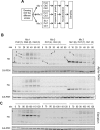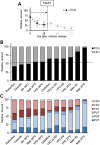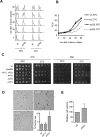Comprehensive and quantitative analysis of G1 cyclins. A tool for studying the cell cycle
- PMID: 31237904
- PMCID: PMC6592645
- DOI: 10.1371/journal.pone.0218531
Comprehensive and quantitative analysis of G1 cyclins. A tool for studying the cell cycle
Abstract
In eukaryotes, the cell cycle is driven by the actions of several cyclin dependent kinases (CDKs) and an array of regulatory proteins called cyclins, due to the cyclical expression patterns of the latter. In yeast, the accepted pattern of cyclin waves is based on qualitative studies performed by different laboratories using different strain backgrounds, different growing conditions and media, and different kinds of genetic manipulation. Additionally, only the subset of cyclins regulating Cdc28 was included, while the Pho85 cyclins were excluded. We describe a comprehensive, quantitative and accurate blueprint of G1 cyclins in the yeast Saccharomyces cerevisiae that, in addition to validating previous conclusions, yields new findings and establishes an accurate G1 cyclin blueprint. For the purposes of this research, we produced a collection of strains with all G1 cyclins identically tagged using the same and most respectful procedure possible. We report the contribution of each G1 cyclin for a broad array of growing and stress conditions, describe an unknown role for Pcl2 in heat-stress conditions and demonstrate the importance of maintaining the 3'UTR sequence of cyclins untouched during the tagging process.
Conflict of interest statement
The authors have declared that no competing interests exist.
Figures





Similar articles
-
Phosphate-activated cyclin-dependent kinase stabilizes G1 cyclin to trigger cell cycle entry.Mol Cell Biol. 2013 Apr;33(7):1273-84. doi: 10.1128/MCB.01556-12. Epub 2013 Jan 22. Mol Cell Biol. 2013. PMID: 23339867 Free PMC article.
-
Interaction of yeast Rvs167 and Pho85 cyclin-dependent kinase complexes may link the cell cycle to the actin cytoskeleton.Curr Biol. 1998 Dec 3;8(24):1310-21. doi: 10.1016/s0960-9822(07)00561-1. Curr Biol. 1998. PMID: 9843683
-
Regulation of cell polarity through phosphorylation of Bni4 by Pho85 G1 cyclin-dependent kinases in Saccharomyces cerevisiae.Mol Biol Cell. 2009 Jul;20(14):3239-50. doi: 10.1091/mbc.e08-12-1255. Epub 2009 May 20. Mol Biol Cell. 2009. PMID: 19458192 Free PMC article.
-
Pho85, a multifunctional cyclin-dependent protein kinase in budding yeast.Mol Microbiol. 2007 Oct;66(2):303-14. doi: 10.1111/j.1365-2958.2007.05914.x. Epub 2007 Sep 10. Mol Microbiol. 2007. PMID: 17850263 Review.
-
Regulation of small GTPase activity by G1 cyclins.Small GTPases. 2019 Jan;10(1):47-53. doi: 10.1080/21541248.2016.1268665. Epub 2017 Jan 27. Small GTPases. 2019. PMID: 28129038 Free PMC article. Review.
Cited by
-
The Critical Role of 12-Methyl Group of Anthracycline Dutomycin to Its Antiproliferative Activity.Molecules. 2022 May 23;27(10):3348. doi: 10.3390/molecules27103348. Molecules. 2022. PMID: 35630823 Free PMC article.
-
Protein Phosphatases in G1 Regulation.Int J Mol Sci. 2020 Jan 8;21(2):395. doi: 10.3390/ijms21020395. Int J Mol Sci. 2020. PMID: 31936296 Free PMC article. Review.
References
Publication types
MeSH terms
Substances
LinkOut - more resources
Full Text Sources
Molecular Biology Databases

